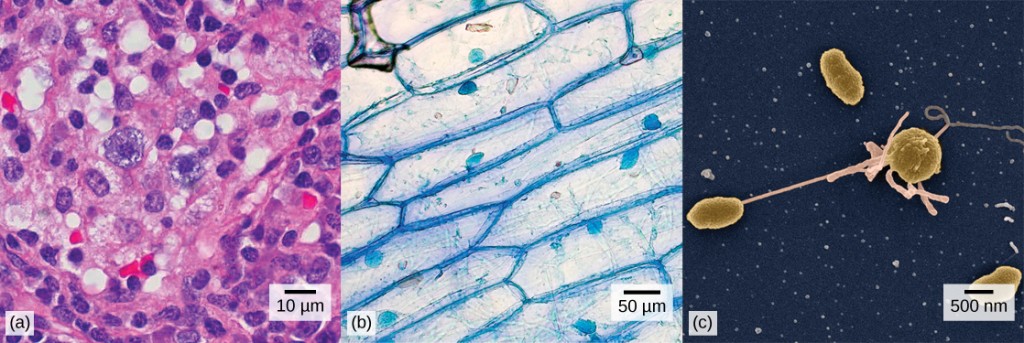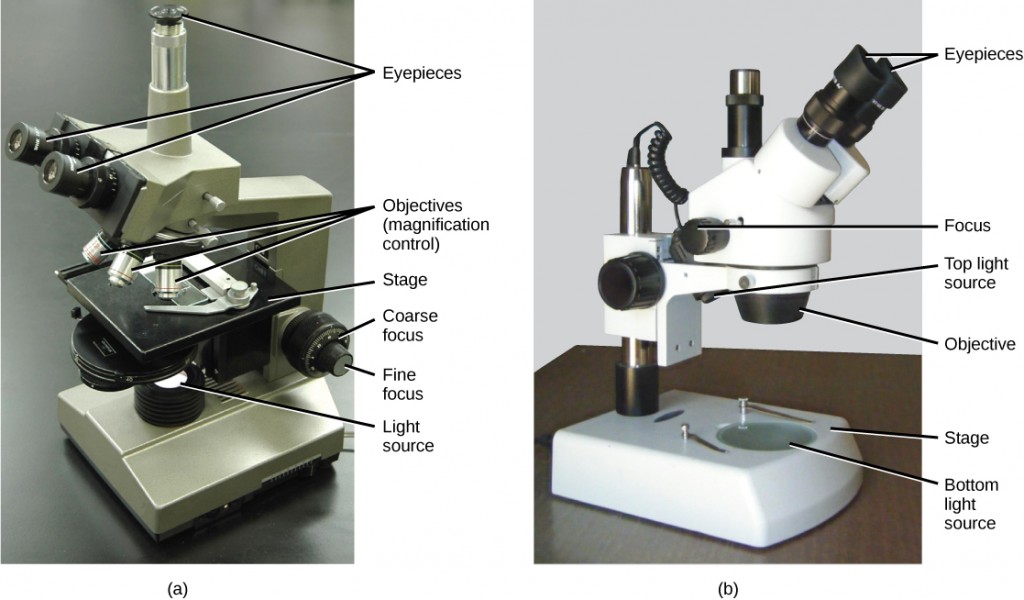Chapter 2: Cells: Theory and Structure

Your body has many kinds of cells, each specialized for a specific purpose. Just as a home is made from a variety of building materials, the human body is constructed from many cell types. For example, epithelial cells protect the surface of the body and cover the organs and body cavities within. Bone cells help to support and protect the body. Cells of the immune system fight invading bacteria. Additionally, red blood cells carry oxygen throughout the body. Each of these cell types plays a vital role during the growth, development, and day-to-day maintenance of the body. In spite of their enormous variety, however, all cells share certain fundamental characteristics.
Cell Theory
Learning Objectives
By the end of this section, you will be able to:
- Describe the roles of cells in organisms
- Summarize the cell theory
A cell is the smallest unit of a living thing. A living thing, like you, is called an organism. Thus, cells are the basic building blocks of all organisms.
In multicellular organisms, several cells of one particular kind interconnect with each other and perform shared functions to form tissues (for example, muscle tissue, connective tissue, and nervous tissue), several tissues combine to form an organ (for example, stomach, heart, or brain), and several organs make up an organ system (such as the digestive system, circulatory system, or nervous system). Several systems functioning together form an organism (such as an elephant, for example).
There are many types of cells, and all are grouped into one of two broad categories: prokaryotic and eukaryotic. Animal cells, plant cells, fungal cells, and protist cells are classified as eukaryotic, whereas bacteria and archaea cells are classified as prokaryotic.
Cells vary in size. With few exceptions, individual cells are too small to be seen with the naked eye, so scientists use microscopes to study them. A microscope is an instrument that magnifies an object.

The microscopes we use today are far more complex than those used in the 1600s by Antony van Leeuwenhoek, a Dutch shopkeeper who had great skill in crafting lenses, and the first scientist to observe cells. Despite the limitations of his now-ancient lenses, van Leeuwenhoek observed the movements of protists (a type of single-celled organism) and sperm, which he collectively termed “animalcules.”
In a 1665 publication called Micrographia, experimental scientist Robert Hooke coined the term “cell” (from the Latin cella, meaning “small room”) for the box-like structures he observed when viewing cork tissue through a lens. In the 1670s, van Leeuwenhoek discovered bacteria and protozoa. Later advances in lenses and microscope construction enabled other scientists to see different components inside cells.
By the late 1830s, botanist Matthias Schleiden and zoologist Theodor Schwann were studying tissues and proposed the unified cell theory, which states that all living things are composed of one or more cells, that the cell is the basic unit of life, and that all new cells arise from existing cells.
Since then, we’ve learned much about cells. All plants and animals are made of cells. Some organisms are single cell organisms, made up of only one cell, while many are multicellular organisms, made up of many cells. All cells have a purpose. In single-cell organisms, like bacteria, the cell performs all the functions needed to keep itself alive. In multicellular organisms, the cells will specialize. Some cells will transport nerve signals while others make up organs, for example.
Cells do not spontaneously appear but are created from other cells. This process is called mitosis and is one of the tenets of cell theory. Cell theory is one of the overarching themes of biology. It has evolved over the years, growing from three points to six, and now includes the idea of passing down genetic material from parent to offspring, as well.
Modern Cell Theory
-
-
- Cells make up all life.
- Cells are functional, structural units.
- Cells are formed by division.
- Cells contain hereditary information.
- Cells are chemically the same.
- Energy flow occurs within cells.
-
Section Summary
A cell is the smallest unit of life. Most cells are so small that they cannot be viewed with the naked eye. Therefore, scientists must use microscopes to study cells. The unified cell theory states that all organisms are composed of one or more cells, the cell is the basic unit of life, and new cells arise from existing cells.
Exercises
- The ___________ is the basic unit of life.
- organism
- cell
- tissue
- organ
- What is the difference between prokaryotic and eukaryotic cells?
- What is the Cell Theory?
Answers
- B
- Eukaryotic cells have organelles and a plasma membrane and make up multicellular organisms. Prokaryotic cells do not have organelles, and make up microorganisms.
- It is the theory that cells are the fundamental unit of all living organisms and that all cells comes from pre-existing cells.
Glossary
unified cell theory: the biological concept that states that all organisms are composed of one or more cells, the cell is the basic unit of life, and new cells arise from existing cells
eukaryotic cells: cells that contain a nucleus and organelles, and are enclosed by a plasma membrane; organisms that have eukaryotic cells include protozoa, fungi, plants and animals
microscope: the instrument that magnifies an object
prokaryotic cells: unicellular organisms that lack organelles or other internal membrane-bound structures
Media Attribution
- Figure 2.1
- Nasal sinus cell: modification of work by Ed Uthman, MD;
- Onion cell: modification of work by Umberto Salvagnin;
- Vibrio tasmaniensis bacterial cells: modification of work by Anthony D’Onofrio; scale-bar data from Matt Russell

